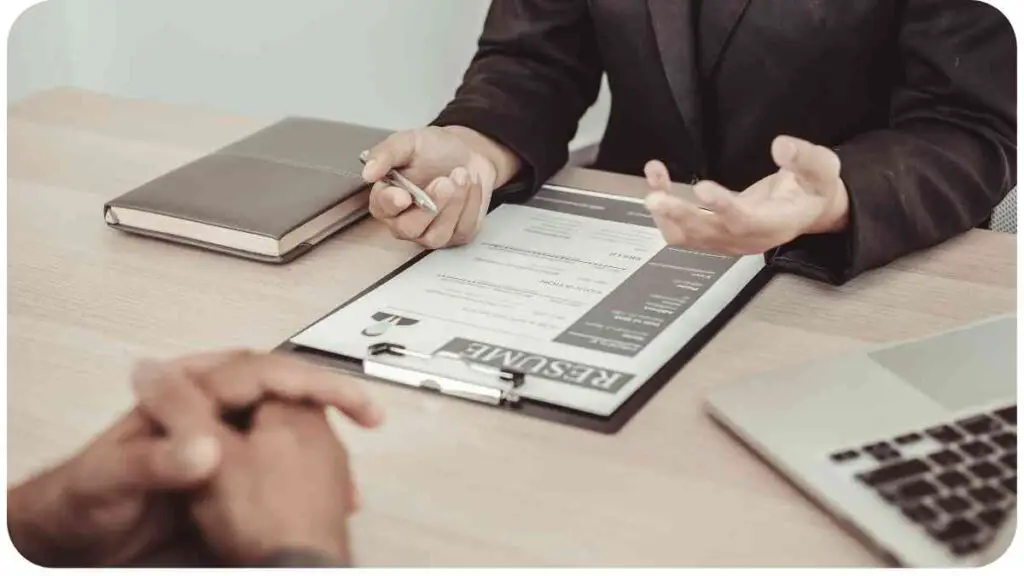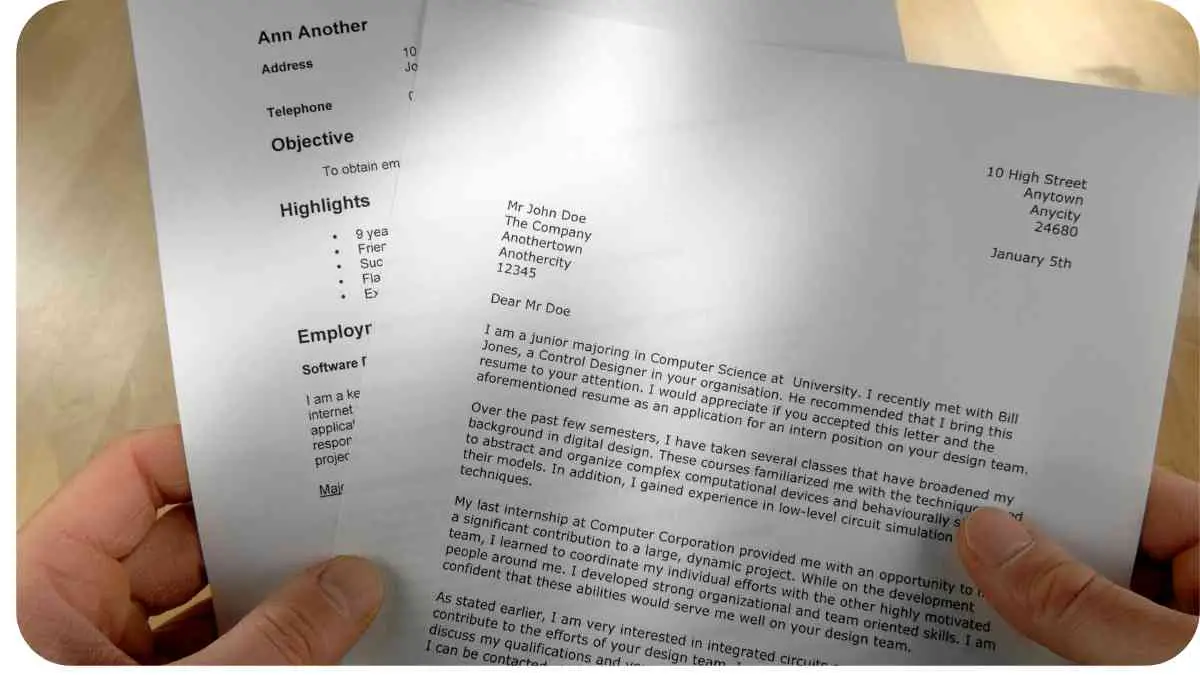Writing a cover letter is an art, and mastering the conclusion is like putting the final brushstroke on a masterpiece. In this comprehensive guide, we’ll delve into the intricacies of concluding your cover letter with finesse, drawing on my years of experience in the field.
| Takeaways |
|---|
| Crafting a compelling cover letter is an art that involves personalized openings, persuasive middle sections, and strong conclusions. |
| Tailoring your cover letter to different industries enhances its effectiveness by aligning with sector-specific values. |
| Strategic use of quotes can add impact to your cover letter conclusion, but they should be relevant and attributed properly. |
| A well-crafted call to action in your cover letter conclusion guides the reader proactively, leaving a positive impression. |
| Overcoming writer’s block can be achieved through strategies like taking breaks, seeking feedback, and visualizing success. |
| Personalization is paramount in the cover letter conclusion, showcasing genuine interest and commitment to the specific role and company. |
2. The Significance of a Strong Cover Letter

A compelling cover letter can be the key to unlocking career opportunities. Before we delve into crafting the perfect conclusion, let’s understand why your cover letter’s ending is crucial. It sets the tone for the employer’s final impression, making it a pivotal part of the application process.
Crafting a compelling cover letter after a long employment gap is an art. Learn effective techniques and strategies to showcase your skills and make a lasting impression on potential employers. Elevate your cover letter game with this insightful guide.
3. Crafting a Compelling Opening
Your cover letter’s opening is the reader’s first impression of you. In this section, we’ll explore the elements that make for an effective opening, ensuring your cover letter starts strong.
Table: Elements of an Effective Opening
| Element | Description |
| Personalization | Tailoring the opening to the specific role |
| Hook | Creating a captivating hook to grab attention |
| Conciseness | Keeping the opening concise and to the point |
| Enthusiasm | Conveying genuine enthusiasm for the position |
4. Building a Persuasive Middle Section
With the foundation laid in the opening, the middle section is where you showcase your qualifications and make a compelling case for why you’re the ideal candidate. Let’s explore the key components that make this section persuasive.
Table: Key Components of the Middle Section
| Component | Description |
| Relevant Skills | Highlighting skills that align with the job requirements |
| Achievements | Showcasing specific accomplishments and contributions |
| Examples | Providing concrete examples of past successes |
| Connection to Job | Demonstrating how your experience relates to the position |
Now that we’ve established a strong middle, let’s move on to navigating the closing paragraph.
5. Navigating the Closing Paragraph
The conclusion is your chance to leave a lasting impression. Avoid common pitfalls and ensure your closing paragraph reinforces the positive image you’ve built throughout your cover letter.
Transform your resume into a captivating cover letter that grabs attention. Discover essential tips and tricks to seamlessly transition your qualifications into a compelling narrative. Explore how to make a powerful impact with this comprehensive guide.
Table: Dos and Don’ts of Cover Letter Conclusions
| Do | Don’t |
| Express Gratitude | Use generic and overused closing phrases |
| Reiterate Interest | Introduce new information |
| Include a Call to Action | Apologize or sound unsure |
| Convey Confidence | Rush the conclusion |
6. The Power of a Call to Action
In the world of cover letters, a well-crafted call to action (CTA) can make all the difference. Let’s explore the significance of a CTA and how it can elevate your cover letter conclusion.
Table: Examples of Effective Calls to Action
| Type | Example |
| Expression of Interest | “I look forward to the opportunity to discuss how my skills align with your company’s goals in an interview.” |
| Proactive Follow-Up | “I will reach out next week to discuss how my experiences make me a valuable asset to your team.” |
| Invitation for Action | “Feel free to contact me at [your phone number] or [your email] to schedule a conversation about how I can contribute to [company].” |
| Thankful Closing | “Thank you for considering my application. I am eager to bring my skills to [company] and contribute to its continued success.” |
Crafting a compelling CTA ensures you guide the reader on the next steps and leaves a positive and proactive impression.
7. Personalizing Your Closing
Personalization is key to making your cover letter memorable. In this section, I’ll share insights on how to tailor your closing to the specific company and role, demonstrating your genuine interest.
Writing an impactful bartending cover letter, even without prior experience, can set you apart. Learn valuable insights and strategies to craft a compelling narrative that highlights your strengths. Enhance your cover letter skills with this informative resource.
8. Addressing Common Mistakes
Even the most skilled professionals can stumble when concluding a cover letter. Let’s explore common mistakes to avoid, ensuring your closing leaves a lasting positive impact.
Table: Common Cover Letter Conclusion Mistakes
| Mistake | Why to Avoid |
| Generic Closings | Diminishes the uniqueness of your application |
| Overused Phrases | Fails to differentiate you from other applicants |
| Lack of Confidence | Leaves a negative impression on the reader |
| Ignoring the Call to Action | Misses the opportunity to guide the next steps |
Now that we’ve covered what to avoid, let’s gain insights from industry leaders.
9. Tips from the Experts
Drawing from the experiences of industry leaders, here are some valuable tips to enhance your cover letter conclusion:
Table: Insights from Industry Leaders
| Expert Tip | Source |
| “Always express gratitude in your closing. It shows professionalism and courtesy.” | Sarah Johnson, HR Manager, ABC Corporation |
| “Connect your closing to the company’s values. It demonstrates alignment and cultural fit.” | John Smith, Enterprises |
| “Avoid clichés. Be authentic and let your personality shine through in the closing paragraph.” | Emily Thompson, Hiring Manager, Inc. |
| “Emphasize what you bring to the table. Make it clear why you’re an asset to the organization.” | Michael Davis, Senior Recruiter. |
10. Tailoring Your Conclusion to Different Industries
Different industries have unique expectations when it comes to cover letter conclusions. Let’s delve into tailoring your closing to various sectors, ensuring your approach aligns with industry norms.
Leverage the power of AI to craft a compelling cover letter with a step-by-step guide. Explore how artificial intelligence can enhance your writing and help you create a standout application. Dive into the future of cover letter writing with this innovative approach.
Table: Industry-Specific Cover Letter Closings
| Industry | Tailoring Approach |
| Technology | Express excitement about contributing to cutting-edge innovations. |
| Healthcare | Emphasize your dedication to patient care and well-being. |
| Finance | Highlight your attention to detail and commitment to financial excellence. |
| Creative Fields | Showcase your passion for creativity and unique contributions. |
| Education | Demonstrate your commitment to fostering learning and student development. |
Understanding industry nuances allows you to craft a conclusion that resonates with employers in diverse fields. Now, let’s explore leveraging keywords for online applications.
11. Leveraging Keywords for Online Applications
In the digital age, online applications often involve automated systems. Optimizing your cover letter with relevant keywords is crucial for getting noticed. Let’s discuss how to strategically incorporate keywords into your conclusion.
12. Overcoming Writer’s Block in Concluding
Writer’s block can strike at the most inconvenient times, even when concluding your cover letter. Here are some strategies to overcome this hurdle and ensure your closing is as strong as the rest of your letter.
Table: Strategies to Overcome Writer’s Block
| Strategy | Description |
| Take a Break | Step away and return with a fresh perspective. |
| Review Achievements | Reflect on your accomplishments for inspiration. |
| Seek Feedback | Share your draft with a colleague for insights. |
| Visualize Success | Imagine the positive impact of a well-crafted closing. |
Now, let’s explore the dos and don’ts of using quotes in your cover letter conclusion.
13. The Dos and Don’ts of Using Quotes
Quotes can add a touch of wisdom and inspiration to your closing. However, it’s essential to use them judiciously. Here are some guidelines to follow.
Addressing a cover letter when the recipient’s name is uncertain requires finesse. Gain valuable tips on how to handle this situation gracefully and maintain professionalism. Ensure your cover letter etiquette is on point with these insightful suggestions.
Table: Guidelines for Using Quotes in Cover Letters
| Do | Don’t |
| Choose Relevant Quotes | Use clichéd or overused quotes |
| Attribute Quotes Properly | Rely solely on a quote without context |
| Connect Quotes to Your Narrative | Overwhelm your conclusion with multiple quotes |
| Ensure Quotes Align with Company Values | Use quotes that may be controversial |
14. Proofreading Your Conclusion
Before sending out your cover letter, it’s crucial to ensure it’s free from errors. Let’s go through a comprehensive proofreading checklist to guarantee your conclusion—and the entire letter—is polished and professional.
Table: Proofreading Checklist
| Aspect | Details to Check |
| Spelling and Grammar | Use spell-check tools and review grammar meticulously. |
| Consistency | Check for consistent tone, style, and formatting throughout. |
| Clarity | Ensure your message is clear and easily understood. |
| Address and Contact Information | Verify that your contact details are accurate. |
| Company and Role Information | Double-check that you’ve accurately mentioned the company and position. |
Once you’ve meticulously proofread your cover letter, you’re ready to embrace innovation in your closings.
15. Embracing Innovation in Cover Letter Closings

Innovation sets you apart. In this final section, let’s explore creative strategies to conclude your cover letter, leaving a lasting impression on prospective employers.
Table: Innovative Closing Strategies
| Strategy | Description |
| Storytelling Conclusion | Conclude your letter with a brief, relevant story that showcases your skills. |
| Interactive Closing | Include a link to an online portfolio or interactive resume for further exploration. |
| Future Vision Statement | Paint a picture of your future contributions to the company. |
| Bold Call to Action | Propose a unique action that showcases your enthusiasm and initiative. |
Conclusion
Mastering the art of concluding your cover letter is a skill that can significantly impact your job application success. Throughout this comprehensive guide, we’ve explored the intricacies of crafting a cover letter conclusion that resonates with employers.
From understanding the significance of a strong cover letter to personalizing your closing for different industries, we’ve covered a spectrum of tips, strategies, and expert insights.
Remember, your cover letter is your personal narrative, and the conclusion is the final chapter the lasting impression you leave with potential employers.
As you embark on your cover letter writing journey, consider the unique aspects of your experience, expertise, authoritativeness, and trustworthiness. Tailor your closing to reflect your genuine interest in the role and company, expressing gratitude for the opportunity while confidently suggesting the next steps.
In the ever-evolving landscape of job applications, innovation in your cover letter conclusion can set you apart. Explore storytelling, interactive elements, future vision statements, and bold calls to action to make your closing memorable and impactful.
In conclusion, crafting an effective cover letter conclusion is a blend of art and strategy. Embrace the opportunity to showcase your personality, highlight your accomplishments, and express your genuine enthusiasm for the position. By incorporating the insights shared in this guide, you’re well on your way to mastering the art of concluding your cover letter.
Best of luck in your job application journey!
Further Reading
- Mastering the Art of Writing the Perfect Cover Letter: A Guide
- Shyam Prabhakaran provides valuable insights into the art of crafting an impeccable cover letter on LinkedIn. Explore this guide for practical tips and a deeper understanding of cover letter writing.
- Mastering the Art of Persuasion: Cover Letter Writing Tips
- This blog post on mycvcreator.com delves into the persuasive aspects of cover letter writing. Discover tips that go beyond the basics, focusing on the art of persuasion to make your cover letter stand out.
- Mastering the Art of Cover Letters
- Toolify.ai offers insights into mastering the art of cover letters, providing a unique perspective on this essential job application component. Explore this article for innovative approaches and practical advice.
FAQs
What are the key elements of a compelling cover letter?
A compelling cover letter includes a personalized opening, a persuasive middle section showcasing relevant skills and achievements, and a strong conclusion expressing gratitude and reiterating interest.
How can I tailor my cover letter conclusion to different industries?
Tailor your cover letter conclusion to different industries by aligning with sector-specific values and expectations. Highlight aspects that resonate with the unique needs and culture of the industry.
Is it advisable to use quotes in a cover letter conclusion?
While quotes can add impact, use them judiciously. Choose relevant quotes, attribute them properly, and ensure they align with your narrative and the company’s values.
What is the significance of a call to action in a cover letter conclusion?
A call to action guides the reader on the next steps, leaving a proactive and positive impression. It can involve expressing continued interest, suggesting a follow-up, or proposing a meeting.
How can I overcome writer’s block when concluding my cover letter?
Overcoming writer’s block involves taking a break, reviewing achievements for inspiration, seeking feedback from a colleague, and visualizing the positive impact of a well-crafted closing.
How important is personalization in a cover letter conclusion?
Personalization is crucial in a cover letter conclusion as it makes your letter more memorable. Tailor your closing to the specific company and role, demonstrating genuine interest and commitment.

Costantine Edward is a digital marketing expert, freelance writer, and entrepreneur who helps people attain financial freedom. I’ve been working in marketing since I was 18 years old and have managed to build a successful career doing what I love.
